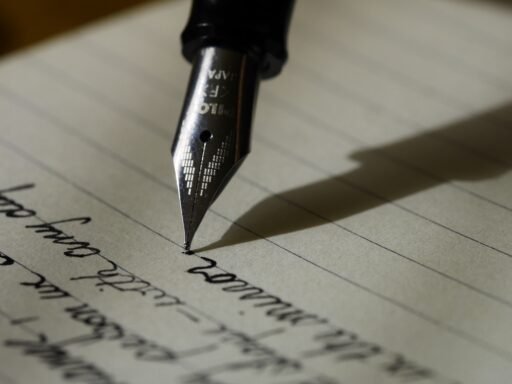You find yourself staring at a blank page, the cursor blinking expectantly, waiting for your words to materialize. Your mind is racing, consumed by a whirlwind of thoughts and emotions. The pressure to convey the raw intensity of a panic attack weighs heavily on your shoulders. In this article “How To Write A Panic Attack”, you will discover the indispensable tools and techniques to capture the essence of a panic attack in your writing. Through cultivating empathy and harnessing the power of descriptive language, you will learn how to skillfully navigate the intricate labyrinth of anxiety and bring it to life on the page.
Understanding Panic Attacks
Definition of a Panic Attack
A panic attack is an intense episode of fear and distress that is accompanied by physical and emotional symptoms. It is an overwhelming experience that can come on suddenly and without any apparent reason. During a panic attack, you may feel a sense of impending doom, as if you are losing control or going crazy. Physical symptoms, such as a racing heart, shortness of breath, trembling, and sweating, may also be present. Panic attacks usually last for a few minutes but can sometimes persist for longer.
Causes of Panic Attacks
Panic attacks can be caused by a variety of factors, including genetics, brain chemistry, and certain life experiences. People with a family history of panic disorder are more likely to experience panic attacks, suggesting a genetic component. Imbalances in brain chemicals, such as serotonin and norepinephrine, can also contribute to the development of panic attacks. Additionally, traumatic events, major life changes, chronic stress, and phobias can all trigger panic attacks in susceptible individuals.
Common Symptoms of a Panic Attack
The symptoms experienced during a panic attack can be both physical and psychological. Physical symptoms often include a rapid heart rate, chest pain or tightness, shortness of breath, dizziness, sweating, trembling, and a sensation of choking. Psychologically, individuals may feel a sense of impending doom or dread, fear of losing control or going crazy, a detached or out-of-body sensation, and intense anxiety. Some people may also experience nausea, hot flashes or chills, and a tingling or numbness in their extremities.
Preparing to Write a Panic Attack
Choosing a Setting for Your Scene
When preparing to write a panic attack scene, it is important to consider the setting carefully. The environment in which the panic attack takes place can have a significant impact on the overall mood and atmosphere of the scene. Consider selecting a setting that is familiar to your protagonist or has personal significance, as this can enhance the emotional impact of the panic attack.
Developing Characters Involved in the Panic Attack
To create a compelling panic attack scene, it is essential to develop realistic and relatable characters who are directly involved in the event. Whether you have a singular protagonist experiencing the panic attack or multiple characters affected by it, their backgrounds, experiences, and relationships should be well-defined. Understand their motivations, fears, and desires to add depth and authenticity to the scene.
Identifying the Triggers for the Panic Attack
To effectively portray a panic attack, you must identify the triggers that lead to its onset. Triggers can vary widely, from specific phobias or traumatic memories to overwhelming stress or a feeling of being trapped. It is crucial to choose a trigger that is relevant to your character’s backstory and consistent with the context of the scene. Researching realistic panic attack triggers can help you create a scene that feels genuine and true to life.

Setting and Atmosphere
Creating a Vivid and Detailed Setting
When describing the setting of a panic attack scene, strive to create a vivid and detailed environment that engages the reader’s senses. Consider the colors, textures, sounds, and smells associated with the chosen location. Utilize descriptive language to paint a clear picture in the reader’s mind and evoke specific emotions. By immersing the reader in the setting, you can heighten the impact of the panic attack.
Establishing the Time and Place
In addition to crafting a detailed setting, it is important to establish the specific time and place in which the panic attack takes place. This information provides context and adds depth to the scene. Consider the significance of the time and how it may contribute to the protagonist’s emotional state. Similarly, consider the relevance of the location and how it may impact the overall atmosphere of the scene.
Describing the Surroundings to Elicit Emotions
To evoke emotions in the reader, it is essential to describe the surroundings in a way that resonates with the feelings the character is experiencing during the panic attack. Use words that evoke a sense of tension, chaos, or vulnerability. Show how the protagonist’s perception of the environment may change due to their heightened anxiety. Describe their heightened sensitivity to stimuli and how it intensifies their panic.
Characterization
Building a Protagonist or Multiple Characters
Characterization is a vital aspect of any panic attack scene. Whether you are focusing on a singular protagonist or multiple characters, invest time in building their identities. Consider their traits, background, relationships, strengths, and flaws. This will make them more relatable to the reader and heighten the emotional impact of the panic attack.
Exploring Their Backgrounds and Experiences
To create fully realized characters, it is necessary to explore their backgrounds and experiences. Delve into their past to uncover key events or traumas that may have shaped their fears or anxieties. Understand their personal history and how it manifests in their response to triggers. By doing so, you can add depth to their reactions during the panic attack and create a more compelling narrative.
Understanding Their Personalities and Traits
Understanding your characters’ personalities and traits is crucial to portraying an authentic panic attack. Consider their strengths and weaknesses, their coping mechanisms, and how they typically respond to stress. By understanding their unique characteristics, you can bring nuance and realism to their actions, thoughts, and feelings during the panic attack.

Trigger Identification and Development
Choosing a Relevant Trigger for the Panic Attack
Selecting a relevant trigger is essential when writing a panic attack scene. The trigger should align with the character’s background, experiences, and fears. It should elicit a strong emotional response and be consistent with the character’s story arc. Take time to consider the trigger carefully, as it acts as the catalyst for the panic attack and shapes the subsequent narrative.
Researching Realistic Panic Attack Triggers
Researching realistic panic attack triggers can help you accurately portray the physiological and psychological responses associated with panic attacks. Consider common triggers such as confined spaces, public speaking, crowds, or specific phobias. Explore real-life accounts and consult reputable sources to understand the breadth of triggers and their potential effects on individuals.
Mapping Out the Emotional Journey to the Trigger
When writing a panic attack scene, it is essential to map out the emotional journey that leads to the trigger. Understand the protagonist’s progression of thoughts, feelings, and physical sensations as anxiety builds. Consider the moments of anticipation, escalating tension, and the eventual overwhelming sense of panic. By charting this emotional trajectory, you can create a compelling and realistic portrayal of the panic attack.
Narrative Techniques
Point of View and Voice
Choose the appropriate point of view and voice to effectively convey the panic attack scene. Second person point of view, addressing the reader directly as “you,” can immerse them in the experience and evoke empathy. Use an empathetic and compassionate tone to help readers connect with the protagonist’s emotions and mindset.
Using Descriptive Writing to Convey Panic
Incorporate descriptive writing techniques to convey the intense emotions and sensations of a panic attack. Utilize sensory details to capture the physical symptoms, such as racing heartbeat or shortness of breath. Describe the protagonist’s thoughts and feelings in vivid, visceral language to create a tangible experience for the reader.
Utilizing Metaphors and Symbolism
Metaphors and symbolism can be used to enhance the reader’s understanding of the panic attack experience. Metaphors can illustrate the protagonist’s internal state or their perception of the world around them. Symbolism can represent deeper meaning or emotions that the character is grappling with. Thoughtfully incorporating these literary devices can enrich the scene and add layers of interpretation.

Building Tension and Suspense
Creating a Sense of Foreboding
To build tension and suspense leading up to a panic attack, create a sense of foreboding throughout the narrative. Foreshadow the impending panic attack through subtle hints or cues. Develop a gradually increasing sense of unease that leaves the reader on edge. This anticipation helps heighten the impact and intensity of the panic attack when it finally occurs.
Managing Pacing and Timing
Effective pacing and timing are essential in portraying a panic attack scene. Control the rhythm of the narrative to mirror the protagonist’s escalating anxiety. Begin with a slower pace, gradually quickening as the panic attack nears. By carefully managing the flow of information and action, you can maintain the reader’s engagement and intensify the impact of the panic attack.
Increasing the Intensity of the Panic Attack
As the panic attack unfolds, intensify the emotional and physical sensations experienced by the protagonist. Heighten the pace of the narrative, utilizing shorter sentences and fragmented thoughts to convey the frantic nature of the attack. Amplify the vividness of the imagery and emphasize the character’s overwhelming fear and disorientation. This gradual increase in intensity enhances the overall impact of the scene.
Describing Physical and Emotional Sensations
Depicting the Physical Symptoms of Panic Attacks
When describing the physical symptoms of panic attacks, focus on sensory details and visceral language to convey the character’s sensations. Describe the pounding heart, the sensation of suffocation, the trembling limbs, and the sweat-soaked skin. Highlight the physical distress experienced during a panic attack to help the reader understand the intensity of the moment.
Exploring the Thoughts and Feelings During a Panic Attack
Go beyond the physical symptoms and delve into the protagonist’s thoughts and emotions during the panic attack. Describe the racing thoughts, the feeling of impending doom, the desperate need to escape. Explore the fear, helplessness, and a loss of control that accompany a panic attack. By illuminating these internal struggles, the reader can empathize and connect with the character’s experience.
Conveying the Fear and Disorientation Experienced
In portraying a panic attack, it is vital to convey the fear and disorientation felt by the character. Utilize evocative language to communicate the character’s feelings of terror, confusion, and inability to focus. Emphasize their sense of detachment from reality and their struggle to make sense of their surroundings. By effectively conveying these emotions, you can create an immersive experience for the reader.
Resolution and Aftermath
How to Conclude the Panic Attack Scene
When concluding a panic attack scene, it is crucial to provide a sense of resolution and closure for the reader. As the panic attack subsides, describe the gradual return to a calmer state. Show the character regaining control over their breathing, their heart rate gradually slowing down. Offer a moment of reflection or introspection to signal the resolution of the panic attack.
Addressing the Aftermath and Recovery
After a panic attack, it is important to address the aftermath and the character’s recovery process. Explore their immediate emotional state, whether it be exhaustion, relief, or residual anxiety. Depict the steps they take to regain their composure and restore a sense of normalcy. Highlight the importance of self-care and seeking support from loved ones or professionals for long-term recovery.
Providing Closure for the Characters
Finally, provide closure for the characters in the aftermath of the panic attack. Give them an opportunity to reflect on their experience, learn from it, and grow as individuals. Consider how the panic attack may impact their future actions, relationships, or character development. By offering closure, you can create a satisfying conclusion to the panic attack scene.
Editing and Polishing the Scene
Reviewing and Revising the Panic Attack Writing
Once you have written the panic attack scene, it is essential to review and revise your work. Look for areas where the scene can be strengthened, both in terms of characterization and emotional impact. Ensure that the pacing and timing are effective, and that the narrative flows seamlessly. Eliminate any inconsistencies or redundancies to streamline the scene.
Eliminating Unnecessary Details or Redundancies
During the editing process, it is important to eliminate any unnecessary details or redundancies that may detract from the scene’s impact. Focus on the essential elements that evoke the desired emotions and remove any extraneous information that may bog down the narrative. Keep the prose concise and impactful to maintain the reader’s engagement.
Seeking Feedback and Making Improvements
To further refine your panic attack scene, seek feedback from trusted readers or writing communities. Ask for constructive criticism and listen to their suggestions for improvement. Consider their perspectives on pacing, characterization, and emotional authenticity. Use this feedback as an opportunity to make necessary revisions and enhance the overall quality of the panic attack scene.
In Conclusion How To Write A Panic Attack
Writing a panic attack scene requires careful consideration of the setting, characters, triggers, and narrative techniques. By understanding the definition, causes, and symptoms of panic attacks, you can create a realistic portrayal that resonates with readers. Through effective scene preparation, vivid setting descriptions, well-developed characters, and an understanding of trigger identification and development, you can craft a panic attack scene that elicits empathy.
Utilizing narrative techniques, building tension and suspense, and describing the physical and emotional sensations of a panic attack will immerse the reader in the character’s experience. Finally, providing resolution, addressing the aftermath, and editing and polishing the scene will ensure a satisfying and impactful conclusion. With these guidelines, you can skillfully write a panic attack scene that captivates readers and authentically conveys the experience of this intense and overwhelming psychological phenomenon.
Frequently Asked Questions:
Q1: What is an example of a panic attack in writing?
In writing, a panic attack might be portrayed as follows: “Her heart raced, breath quickened, and a suffocating wave of fear swept over her, making it feel as if the world was closing in, trapping her in an overwhelming sense of dread.”
Q2: How do you show panic in writing?
To convey panic in writing, utilize vivid descriptions of physical sensations, racing thoughts, and heightened emotions. Illustrate the character’s internal struggle, allowing readers to empathize with the intensity of the moment.
Q3: How do you describe a panic attack?
A panic attack can be described as a sudden surge of intense anxiety, accompanied by physical symptoms like a rapid heartbeat, shortness of breath, dizziness, and a feeling of impending doom.
Q4: How do you write an anxiety attack accurately?
Write an anxiety attack accurately by detailing the physiological and emotional aspects. Capture the character’s thoughts, bodily reactions, and the surrounding environment to create a realistic and immersive portrayal.
Q5: How do you write a mental breakdown scene?
When writing a mental breakdown scene, delve into the character’s internal chaos. Describe their emotional unraveling, erratic behavior, and the impact on their surroundings, conveying the intensity of the breakdown.
Q6: How do you write someone hyperventilating?
To depict hyperventilation in writing, highlight the character’s rapid and shallow breathing. Use phrases like “gasping for air” and “chest heaving” to convey the intensity of hyperventilation.
Q7: How long do panic attacks last?
The duration of panic attacks varies, but they typically last around 10 to 30 minutes. However, the aftermath effects can linger, and individuals may feel exhausted or emotionally drained.
Q8: How do you write someone with PTSD?
Writing a character with PTSD involves careful research and portrayal of their specific symptoms. Address their triggers, flashbacks, and emotional responses authentically, emphasizing the complexity of their experiences.
Q9: What are words to describe anxiety in writing?
Words to describe anxiety in writing include: overwhelming, paralyzing, relentless, suffocating, palpable, and consuming. Choose words that evoke a visceral response to convey the depth of anxiety.
Q10: Can you cry during a panic attack?
Yes, crying can be a common emotional response during a panic attack. It is a natural release of pent-up emotions and can accompany the overall intense experience.
Q11: Do you scream during a panic attack?
Screaming is a possible manifestation of a panic attack, especially if the individual feels an overwhelming urge to express or release their heightened emotions.
Q12: Can you have a one-off panic attack?
Yes, individuals can experience a one-off panic attack, often triggered by a specific stressor. However, recurring panic attacks may indicate an underlying anxiety disorder.
Q13: What not to say during an anxiety attack?
Avoid dismissing or trivializing the person’s feelings. Instead, offer support, validate their emotions, and encourage them to seek professional help if needed.
Q14: How do you express anxiety physically?
Physical expressions of anxiety can include fidgeting, restlessness, trembling, sweating, pacing, and changes in posture. Use these details to convey the character’s physical response to anxiety.
Q15: What is the perfect way to describe anxiety?
The perfect way to describe anxiety involves a nuanced portrayal that captures both the internal turmoil and external manifestations. Use evocative language to convey the complexity and impact of anxiety on the individual.